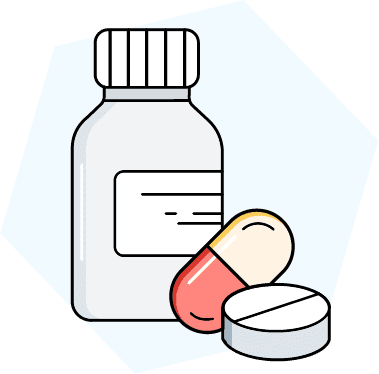In 2022, President Joe Biden signed the Inflation Reduction Act (IRA) into law. This legislation intended to reduce the federal deficit by $237 billion by raising revenue through corporation taxes, increasing tax enforcement, and reforming prescription drug pricing.
If you’re a Medicare beneficiary, the prescription drug reform could affect what you pay for your medications. Here’s what you need to know about the upcoming negotiations and how they might affect your wallet.
Table of Contents
What Is the Inflation Reduction Act?

The IRA includes many important improvements for Medicare recipients. One of those changes is the Medicare prescription drug payment plan, which would allow Part D Medicare enrollees to pay their out-of-pocket prescription drug costs as a monthly installment payment instead of a lump sum at the pharmacy. This helps to spread your expenses over the year so you’re not slammed with a big bill all at once.
The law caps out-of-pocket drug costs at $2,000 starting in 2025, and limits insulin costs to $35 per product to help reduce your expenses. Another benefit of the IRA is the extension of the enhanced tax credits that helped 13 million people save an average of $800 on their insurance. Drug manufacturers must also pay rebates to Medicare if drug prices rise faster than inflation.
However, one of the more important parts of this act is the Medicare drug price negotiation program. Under this program, the Centers for Medicare and Medicare Services (CMS) can negotiate with major drug manufacturers to reduce common drug costs. The goal is to find a fair price for both sides so the government (and you) can spend less on healthcare costs.
When Do Negotiated Drug Prices Go Into Effect?
Currently, the Biden administration is beginning negotiations with drug manufacturers. This process continues throughout the spring and summer. Final negotiated prices should be released for the first 10 drugs on September 1, 2024. The prices for these drugs then take effect in January 2026.
If all goes well, the process would likely continue each year, with drug negotiations going on roughly two years before the new price being rolled out. For example, here’s what the complete timeline looks like for 2027:
- February 1, 2025: Drugs selected for negotiation published
- February 28, 2025: Negotiation begins
- November 1, 2025: Negotiation ends
- November 30, 2025: Fair prices published
- January 1, 2027: Negotiated prices take effect
How Many Drugs Could Have Their Prices Negotiated?

According to IRA provisions, a total of 60 drugs are going to have their prices negotiated over the next 5 years. These include:
- 10 Part D drugs for 2026
- 15 Part D drugs for 2027
- 15 Part D and Part B drugs for 2028
- 20 Part D and Part B drugs for 2029
How Does CMS Select Which Drug Prices to Negotiate?
To decide which drug prices to negotiate, the Secretary of Health and Human Services can pull from the 50 Part D and 50 Part B drugs with the highest costs. The drugs must be single-source brand-name drugs or biologics without generic or biosimilar competitors.
However, some drugs are excluded from potential negotiations. Exclusion criteria include:
- Small-molecule drugs less than 9 years old or a biological product less than 13 years old
- Small biotech drugs that account for 1% or less of Part D and B spending
- Drugs that account for less than $200 million in Medicare spending in 2021
- Plasma-derived products
- Approved by the FDA as an orphan drug
What Are the First Drugs to Have Their Prices Negotiated?
In October 2023, the Centers for Medicare and Medicare Services (CMS) announced the first Medicare Part D drugs to undergo negotiations. These drugs include:
- Eliquis
- Enbrel
- Entresto
- Farxiga
- Fiasp; Fiasp FlexTouch; Fiasp PenFill; NovoLog; NovoLog FlexPen; NovoLog PenFill
- Imbruvica
- Januvia
- Jardiance
- Stelara
- Xarelto
Beyond the First Drugs: Long-Term Implications for the Market

Considering the first drugs the Biden administration has selected for price negotiations, there is potential for big savings. Those drugs cost Medicare and Medicare beneficiaries $50.5 billion between June 1, 2022, and May 31, 2023. That equaled about 20% of Medicare Part D spending. By negotiating drug prices, the Congressional Budget Office estimates Medicare can save about $98.5 billion over 10 years. Much of those savings might be passed on to consumers, lowering what you pay for your Part D costs.
The IRA might also convince drug manufacturers to start lowering prices on their own. That’s because the law mandates that drug manufacturers pay Medicare a rebate if their drug prices rise faster than inflation. To avoid this, manufacturers are encouraged to voluntarily keep their prices at a fair market price.
Companies that do not comply with the IRA can also face big penalties. For example, the government can charge them an excise tax of 65% of a product’s sales in the U.S. If the company still refuses to negotiate, the penalty can increase by 10% every quarter up to a limit of 95%. Such a high penalty could mean drug companies are more willing to make concessions and lower prices for consumers.
How to Prepare for Future Drug Price Changes
There’s nothing you need to do to prepare for future prescription drug price changes. Even if you take one of the 10 drugs being negotiated, price changes do not go into effect until 2026. When that date arrives, you might experience lower out-of-pocket drug costs.
Until then, one way to lower your Medicare Part D costs is to compare different plans. Private insurers offer Part D coverage, meaning there are a variety of premiums, deductibles, and copayments. Research the plans available in your area to find the one that offers a good value for your health needs.
When CMS announces the next round of drug price negotiations, it may also host patient-focused listening sessions you can attend to share your input and learn more about the process. Keep an eye out for these sessions to stay well informed about Medicare drug price changes.
